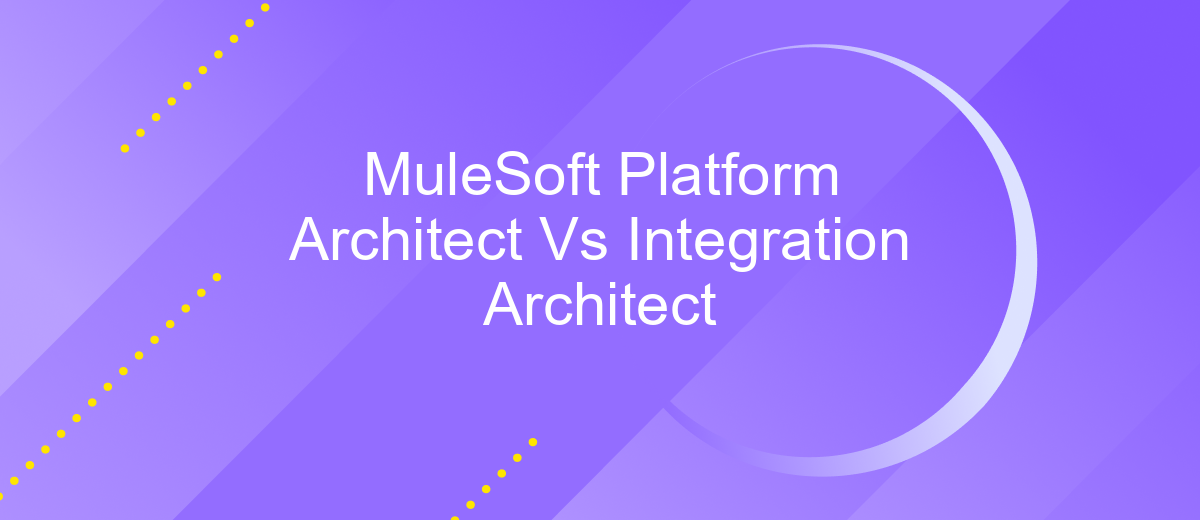MuleSoft Platform Architect Vs Integration Architect
In the rapidly evolving landscape of enterprise technology, distinguishing between a MuleSoft Platform Architect and an Integration Architect is crucial for effective project execution. Both roles are pivotal in ensuring seamless data flow and system interoperability, yet they possess distinct responsibilities and skill sets. This article delves into their unique functions, helping organizations make informed decisions when building their integration strategies.
Overview
When comparing a MuleSoft Platform Architect to an Integration Architect, it's essential to understand their unique roles and responsibilities. Both positions focus on enabling seamless integrations, but they approach the task from different angles.
- MuleSoft Platform Architect: Specializes in designing and managing MuleSoft-based integration solutions. They ensure that the MuleSoft platform is effectively utilized to meet business needs.
- Integration Architect: Focuses on the broader integration landscape, which may include multiple tools and platforms. They design end-to-end integration solutions that connect various systems and applications.
While a MuleSoft Platform Architect is deeply versed in MuleSoft's capabilities, an Integration Architect may leverage a variety of tools, such as ApiX-Drive, to facilitate integrations. ApiX-Drive is a powerful service that automates data transfer between different systems, enhancing the efficiency and reliability of integration processes. Understanding these differences helps organizations assign the right expert to their integration projects.
Roles and Responsibilities

A MuleSoft Platform Architect is primarily responsible for designing and implementing integration solutions using the MuleSoft platform. They focus on creating scalable, secure, and efficient integration architectures that meet business requirements. This role involves extensive collaboration with stakeholders to understand their needs and translating them into technical specifications. Additionally, a MuleSoft Platform Architect ensures that best practices and standards are followed, and they often provide guidance and support to development teams throughout the project lifecycle.
On the other hand, an Integration Architect has a broader scope, encompassing various integration platforms and technologies. They are tasked with overseeing the entire integration landscape of an organization, which includes designing, implementing, and managing integration solutions across different systems. An Integration Architect must ensure seamless data flow and communication between disparate systems. Tools like ApiX-Drive can be instrumental in this role, as they simplify the process of connecting and automating workflows between numerous applications, enhancing overall efficiency and reducing manual intervention. Both roles are crucial for maintaining robust and effective integration frameworks within an organization.
Skillset and Experience

The skillset and experience required for a MuleSoft Platform Architect versus an Integration Architect differ significantly, although both roles are crucial in the integration landscape. A MuleSoft Platform Architect focuses on designing and implementing MuleSoft solutions, ensuring that the platform is used to its full potential. They require deep knowledge of MuleSoft Anypoint Platform, API-led connectivity, and experience with CI/CD pipelines.
- Proficiency in MuleSoft Anypoint Platform and API-led connectivity.
- Experience with CI/CD pipelines and DevOps practices.
- Strong understanding of API management, security, and governance.
- Ability to design scalable and reusable APIs and integrations.
- Knowledge of cloud platforms such as AWS, Azure, or Google Cloud.
On the other hand, an Integration Architect requires a broader skillset, encompassing various integration tools and platforms. They must be adept at using services like ApiX-Drive to streamline and automate integrations across different systems. Their expertise includes understanding enterprise integration patterns, middleware solutions, and ensuring seamless data flow between applications. Both roles demand strong analytical skills, problem-solving abilities, and excellent communication skills to collaborate effectively with stakeholders.
Education and Training

Both MuleSoft Platform Architects and Integration Architects require a solid educational foundation in computer science, information technology, or a related field. A bachelor's degree is typically the minimum requirement, though many professionals pursue advanced degrees to deepen their expertise and improve their career prospects.
In addition to formal education, specialized training and certifications are crucial for these roles. MuleSoft Platform Architects often seek MuleSoft Certified Developer and MuleSoft Certified Integration Architect credentials to validate their skills in designing and managing the MuleSoft Anypoint Platform. Integration Architects, on the other hand, might focus on broader certifications such as TOGAF or specific technology certifications relevant to the systems they work with.
- MuleSoft Certified Developer
- MuleSoft Certified Integration Architect
- TOGAF Certification
- Relevant technology-specific certifications
Continuous learning is essential in these dynamic fields. Platforms like ApiX-Drive offer valuable resources and tools for integrating various services, which can be particularly beneficial for Integration Architects. Staying updated with the latest technologies and best practices ensures that both MuleSoft Platform Architects and Integration Architects can effectively design, implement, and manage complex integration solutions.
Career Path and Salary
The career path for a MuleSoft Platform Architect typically involves extensive experience in software development, system integration, and cloud technologies. These professionals are responsible for designing and implementing complex integration solutions, often using MuleSoft's Anypoint Platform. With a deep understanding of APIs and integration patterns, they ensure seamless data flow across various systems. On the other hand, an Integration Architect focuses on the broader scope of integrating different technologies and platforms, which may include tools like ApiX-Drive to automate and simplify integration processes. Both roles require continuous learning and certification to stay updated with evolving technologies.
In terms of salary, MuleSoft Platform Architects generally command higher compensation due to their specialized skill set and the demand for MuleSoft expertise. According to industry data, their annual salaries can range from 0,000 to 0,000, depending on experience and location. Integration Architects also earn competitive salaries, typically ranging from 0,000 to 0,000 annually. The growing need for seamless integration across diverse systems ensures robust career prospects and attractive remuneration for both roles.


FAQ
What is the primary difference between a MuleSoft Platform Architect and an Integration Architect?
What are the core responsibilities of a MuleSoft Platform Architect?
How does an Integration Architect approach system integration differently than a MuleSoft Platform Architect?
Which role is more suitable for a company that uses multiple integration platforms?
Can either role benefit from using automation and integration services like ApiX-Drive?
Apix-Drive is a simple and efficient system connector that will help you automate routine tasks and optimize business processes. You can save time and money, direct these resources to more important purposes. Test ApiX-Drive and make sure that this tool will relieve your employees and after 5 minutes of settings your business will start working faster.

